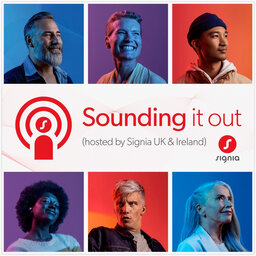4.2 Exploring Invisible Disabilities and Hearing: A Conversation with Professor Andrew Hugill
In this episode, Professor Hugill and Julia delve into how invisible disabilities impact hearing experiences, discussing terms like neurodivergence and aural divergence. The conversation explores tinnitus, its effects on musicians, auditory processing disorder (APD), misophonia, diplacusis, and palinacousis.
They emphasize the importance of patient-centered care and raising awareness about aural diversity.
Check out the Aural Diversity webpage for more information: https://auraldiversity.org/
EPISODE SUMMARY
the second and final episode of 'Sounding It Out’, Series 4, Julia Van Huyssteen, Head of Audiology at Signia UK and Ireland, hosts Professor Andrew Hugill from the University of Leicester to explore beyond the audiogram into various individual experiences of hearing. They delve into conditions like neurodivergence and aural divergence, explaining terms such as tinnitus, auditory processing disorder (APD), misophonia, diplacusis, and palinacousis. Professor Hugill shares personal insights and discusses the complexity each condition brings, especially in musicians.
He likens neurodivergence to the difference between operating systems like Windows and Mac. They talk about how often individuals with normal audiograms still struggle to process sound and the potential overlap with other conditions, emphasizing the need for personalized patient care. The importance of raising awareness about these conditions, making reasonable adjustments, and providing appropriate support is underscored.
The episode stresses the importance of patient-centered care, acknowledging the unique needs and circumstances of each individual. Listeners are encouraged to visit the Aural Diversity Network website for further information and to revisit previous episodes of the podcast to expand their understanding of hearing health.
Finally, the show calls for more dialogue on less-known conditions and invites listeners to suggest future topics to continue raising awareness about aural diversity.
 Sounding It Out
Sounding It Out


